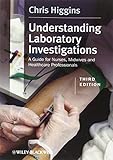Understanding laboratory investigations : a guide for nurses, midwives and health professionals / Chris Higgins.
Material type: TextPublication details: Oxford : Wiley-Blackwell, 2013.Edition: 3rd edDescription: 424 pISBN:
TextPublication details: Oxford : Wiley-Blackwell, 2013.Edition: 3rd edDescription: 424 pISBN: - 9780470659519 (pbk.) :
- 9780470659519 (pbk.) :
- 616.0756 HIG
- RB37 .H544 2013
| Item type | Current library | Call number | Copy number | Status | Date due | Barcode | |
|---|---|---|---|---|---|---|---|
| Long Loan | TUS: Midlands, Main Library Athlone Nursing Collection | 616.0756 HIG (Browse shelf(Opens below)) | 1 | In transit from TUS: Midlands, Main Library to Nursing collection room since 07/08/2019 | 217416 | ||
| Long Loan | TUS: Midlands, Main Library Athlone Nursing Collection | 616.0756 HIG (Browse shelf(Opens below)) | 1 | Available | 217417 | ||
| Long Loan | TUS: Midlands, Main Library Athlone Nursing Collection | 616.0756 HIG (Browse shelf(Opens below)) | 1 | Available | 217420 | ||
| Two Hour Loan | Nursing collection room AIT 2 Hour Loan | 616.0756 HIG (Browse shelf(Opens below)) | 1 | Available | 217419 | ||
| Long Loan | TUS: Midlands, Main Library Athlone General Lending | 616.0756 HIG (Browse shelf(Opens below)) | 1 | Available | 217418 |
Previous ed.: published as Understanding laboratory investigations for nurses and health professionals. Oxford: Blackwell, 2007.
Includes bibliographical references and index.
Part 1: Introduction:- 1. Introduction to clinical laboratories -- 2. Some principles of laboratory testing -- Part 2: Clinical biochemistry tests:-3. Blood glucose and HbA1c -- 4.Plasma/serum sodium and potassium -- 5. Plasma/serum urea and creatinine, and e-GFR -- 6. Plasma/serum calcium and phosphate -- 7. Arterial blood gases -- 8. Plasma/serum cholesterol and triglycerides -- 9. Cardiac markers - troponin, creatine kinase (MB) and brain natriuretic peptide (BNP) -- 10. Tests of thyroid function -- thyroxine (T4), triiodothyronine (T3) and thyroid stimulating hormone (TSH) -- 11. Liver function tests: alanine transferase (ALT), gamma glytamyl trasnferase (GGT), alkaline phosphatase (AP), bilirubin and albumin -- 12. Plasma/serum amylase -- 13. Drug overdose: paracetamol and salicylate -- 14.Therapeutic drug monitoring: lithium, digoxin and theophylline -- Part 3: Haematology tests:- 15. Full blood count - 1: red blood cell count, haemoglobin and other red cell indices -- 16. Full blood count - 2: white cell count and differential -- 17. Tests of haemostasis: platelet count, prothrombin time (PT), activated partial thromboplastin time (APPT), Thrombin time (TT) and D-dimer -- Prt 4: Blood transfusion testing:- 20. Blood group, antibody screen and crossmatch -- Part 5:Microbiology testing:- 21. Urine microscopy, culture and sensitivity (M.C&S) -- 22. Blood culture -- Part 6: Screening tests:- 23. Newborn screening blood tests -- 24. Cervical screening test -- 25. Dipstick testing of urine.
Providing nurses with information about the tests performed on patient samples in hospital laboratories, including clinical relevance of test results, this work explains the physiological function being measured, details of reference ranges and the clinical significance of test results for diagnosis or patient monitoring.
